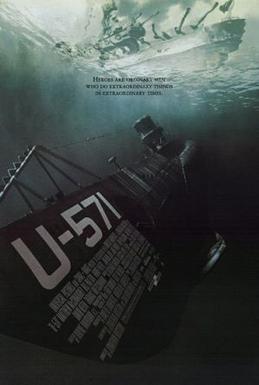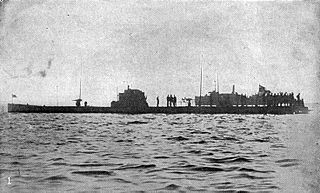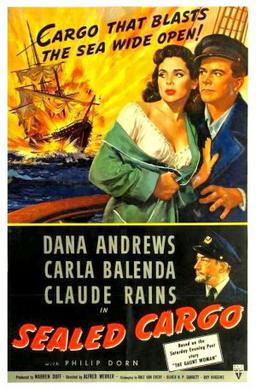
Das Boot is a 1981 West German war film written and directed by Wolfgang Petersen, produced by Günter Rohrbach, and starring Jürgen Prochnow, Herbert Grönemeyer and Klaus Wennemann. It has been exhibited both as a theatrical release (1981) and a TV miniseries (1985). Several different home video versions, as well as a director's cut (1997) supervised by Petersen, have also been released.

U-boats were naval submarines operated by Germany, particularly in the First and Second World Wars. The term is an anglicized version of the German word U-Boot, a shortening of Unterseeboot, though the German term refers to any submarine. Austro-Hungarian Navy submarines were also known as U-boats.

U-571 is a 2000 submarine film directed by Jonathan Mostow from a screenplay he co-wrote with Sam Montgomery and David Ayer. The film stars Matthew McConaughey, Bill Paxton, Harvey Keitel, Jon Bon Jovi, Jake Weber and Matthew Settle. The film follows a World War II German submarine boarded by American submariners to capture her Enigma cipher machine.

The submarine film is a subgenre of war film in which most of the plot revolves around a submarine below the ocean's surface. Films of this subgenre typically focus on a small but determined crew of submariners battling against enemy submarines or submarine-hunter ships, or against other problems ranging from disputes amongst the crew, threats of mutiny, life-threatening mechanical breakdowns, or the daily difficulties of living on a submarine.

The Spy in Black is a 1939 British film, and the first collaboration between the British filmmakers Michael Powell and Emeric Pressburger. They were brought together by Alexander Korda to make the World War I spy thriller novel of the same title by Joseph Storer Clouston into a film. Powell and Pressburger eventually made over 20 films during the course of their partnership.

In Enemy Hands is a 2004 American submarine film directed by Tony Giglio and starring William H. Macy, Til Schweiger, Thomas Kretschmann, Scott Caan and Lauren Holly. The film follows an American submarine crew getting captured by a German submarine crew and taken prisoner aboard their U-boat.

Anti-submarine warfare is a branch of underwater warfare that uses surface warships, aircraft, submarines, or other platforms, to find, track, and deter, damage, or destroy enemy submarines. Such operations are typically carried out to protect friendly shipping and coastal facilities from submarine attacks and to overcome blockades.

German submarine U-66 was a Type IXC U-boat of Nazi Germany's Kriegsmarine during World War II. The submarine was laid down on 20 March 1940 at the AG Weser yard at Bremen, launched on 10 October and commissioned on 2 January 1941 under the command of Kapitänleutnant Richard Zapp as part of the 2nd U-boat Flotilla.

SM U-20 was a German Type U 19 U-boat built for service in the Imperial German Navy. She was launched on 18 December 1912, and commissioned on 5 August 1913. During World War I, she took part in operations around the British Isles. U-20 became infamous following her sinking of the British ocean liner RMS Lusitania on 7 May 1915, an act that dramatically reshaped the course of the First World War.
The following events occurred in May 1942:

Action in the North Atlantic is a 1943 American war film from Warner Bros. Pictures. It was produced by Jerry Wald, directed by Lloyd Bacon, and adapted by John Howard Lawson from a story by Guy Gilpatric. The film stars Humphrey Bogart and Raymond Massey as officers in the U.S. Merchant Marine during World War II.

The Battle of the Caribbean refers to a naval campaign waged during World War II that was part of the Battle of the Atlantic, from 1941 to 1945. German U-boats and Italian submarines attempted to disrupt the Allied supply of oil and other material. They sank shipping in the Caribbean Sea and the Gulf of Mexico and attacked coastal targets in the Antilles. Improved Allied anti-submarine warfare eventually drove the Axis submarines out of the Caribbean region.

Ghostboat is a 2006 British television film, based on a novel by George E. Simpson and Neal R. Burger. The film features David Jason as its star. It is a fantasy tale of His Majesty's Submarine Scorpion vanishing during the Second World War, leaving only one crew member surviving. 38 years later, in the Cold War year 1981, the Scorpion reappears; the crew have disappeared, but the vessel is otherwise unchanged and has not aged in the intervening years. A Royal Navy crew along with the sole survivor of the original voyage is given the mission of retracing the last days of the boat prior to her 1943 disappearance. A supernatural influence takes hold of most of the crew, and they start showing characteristics of the old crew. They find themselves fighting Second World War ghosts.

SM U-53 was one of the six Type U 51 U-boats of the Imperial German Navy during the First World War. While in command of U-53 her first captain Hans Rose became the 5th ranked German submarine ace of World War I sinking USS Jacob Jones and 87 merchant ships for a total of 224,314 gross register tons (GRT).

Sealed Cargo is a 1951 American war film about a fisherman, played by Dana Andrews, who gets tangled up with Nazis and their U-boats. Claude Rains, Carla Balenda, and Philip Dorn co-starred. Andrews' younger brother, actor Steve Forrest, had a small, uncredited part, one of his earliest screen roles. The movie was based on the novel The Gaunt Woman by Edmund Gilligan.

Mystery Submarine is a 1950 American war film directed by Douglas Sirk and starring Macdonald Carey, Märta Torén and Robert Douglas.
The Torpedo Alley, or Torpedo Junction, off North Carolina, is one of the graveyards of the Atlantic Ocean, named for the high number of attacks on Allied shipping by German U-boats in World War II. Almost 400 ships were sunk, mostly during the Second Happy Time in 1942, and over 5,000 people were killed, many of whom were civilians and merchant sailors. Torpedo Alley encompassed the area surrounding the Outer Banks, including Cape Lookout and Cape Hatteras.

The Navy Comes Through is a 1942 American World War II film directed by A. Edward Sutherland. It stars Pat O'Brien, George Murphy and Jane Wyatt. Vernon L. Walker and James G. Stewart were nominated for an Oscar for Best Special Effects. The film was based on Borden Chase's 1939 short story "Pay to Learn". The working titles of the film were Pay to Learn and Battle Stations. The film was the first RKO Pictures use of a new radio signal trademark that spelled out the word "victory." Prior to this, the studio's radio signal trademark spelled out "RKO."

Result is a three-masted cargo schooner built in Carrickfergus in 1893. She was a working ship until 1967, and served for a short time in the Royal Navy as a Q-ship during World War I. She currently rests on land at the Ulster Folk and Transport Museum, and in 1996 was added to the National Register of Historic Vessels.
The following events occurred in May 1944:

















